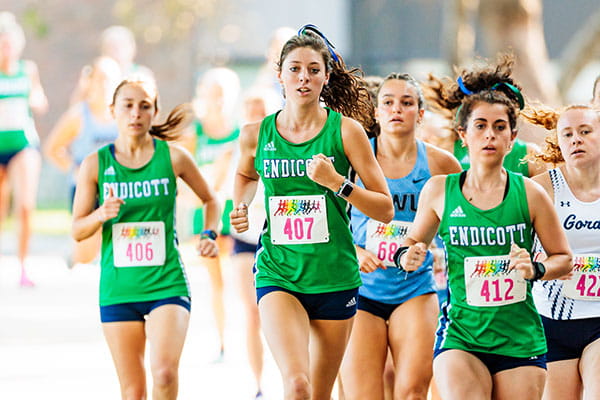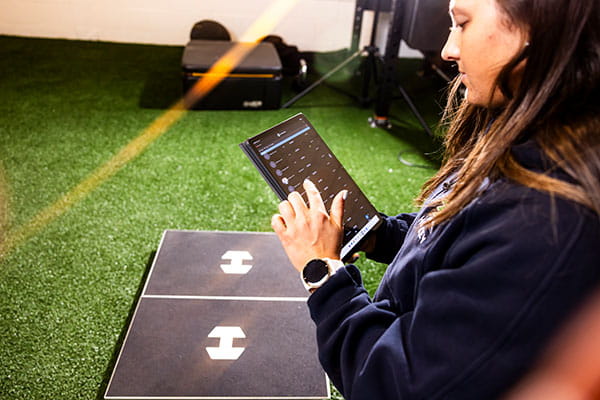Developing the Whole Student-Athlete

There’s an athletic development standard with roots dating back to the ancient Olympics, which has an established role in the European soccer leagues and is seeing significant growth in the U.S. professional and collegiate athletic circles. It’s called the high-performance training model, and now it’s at Endicott.
The idea is straightforward: to care for the whole of the athlete, physically and mentally, and give them the tools they need to train and perform at their best. The model brings together applied sports science and analytics, athletic training and sports medicine, sport psychology, sports nutrition, strength and conditioning, and sleep and recovery under one umbrella, along with a team of professionals who combine efforts to provide comprehensive care that’s autonomous from sport coaching.
Dr. James T. Daley, Assistant Director of Athletics and Athletic Performance is the driving force behind establishing this model. Here it’s called Endicott Athletic Performance, and Daley said the importance of formalizing it is to outline the philosophy that the College fully supports its student-athletes, on and off the field.
“We place significant demands on our student-athletes when we ask them to wear Endicott on their chests,” he said. “The best support we can give them is to help them holistically develop as humans in a way that sets them up for the rest of their lives. We’re here to win, but we care about them as people, and that’s something very special.”

Jack Dustin, Head Strength & Conditioning Coach, said the model adds valuable insight into a student-athlete’s everyday life and what stressors and demands are weighing on them.
“It’s a collaborative effort to help student-athletes come back from injury or improve their base level of fitness,” he explained. “All these different elements need to come together to help the student-athlete realize what it takes to push everything to the next level, whether it be academically, athletically, or socially.”
Exercise science major Kyan Bagshaw ’26, who is a member of the Gulls baseball team, said the sport psychology support staff helped him reorient his relationship with goal-setting.
“I’m familiar with end-goals, saying I want to throw 95 [mph pitch], for instance,” he shared. “But they taught me about progress goals, something I’d never heard of before. I can make a goal for practice for myself every day, and if I hit those, incrementally, I’m going to get better. I’m a big picture guy, so that’s a new mental performance tool that helps me elevate my game.”
Abby Antonelli ’26, an exercise science major who plays field hockey, said the collaborative model provides a cornerstone of health education that will benefit student-athletes long after college.
“Once a student-athlete graduates, it’s not like their competitive career is over,” she said. “So being able to continue to take care of our bodies, and sleep well, and have those skills, will benefit us throughout our entire life. I know the field hockey team is looking forward to working with sports nutrition and learning how to fuel our bodies better.”
Bagshaw agreed that the lessons have long-term applicability.
“You can take what you’ve learned and apply it to life outside athletics—exams, big meetings, big calls, whatever it may be,” he explained. “I’m huge on breathing now. And when I feel my heart race, I understand to take a second to breathe, get my mind right, and then go attack.”
Through this high-performance model, Endicott is once again blazing trails amongst peers.
Not only is the College the first in the Commonwealth Coast Conference to launch this type of model, but the Gulls are doing additional things you don’t see often in DIII nationwide, like establishing a staff position that oversees athletic performance as a whole or providing these collaborative opportunities and resources to varsity teams as well as to club student-athletes.
Recently, the NCAA highlighted data from a national health and wellness study of college athletes in 2022-23. In Division III, the top three wellness topics that student-athletes want to learn more about are proper nutrition, mental wellness, and getting quality sleep.
“We have the ability to listen to our student-athletes and coaches and be understanding of what’s going on in the landscape,” Daley explained. “We’re not afraid to take a chance and move to something that may be unproven at this level, and now it's going to pay dividends for us. We want to be able to make data-driven decisions; actional steps that we take to drive long-term athletic development and lifelong habits.”
Many of these resources are not new to Endicott students and student-athletes. Places like the Wellness Center focus on physical and behavioral health. Strength and conditioning coaches help student-athletes train effectively and set goals. But under Daley’s direction, the College has gathered all these elements together, honed approaches, and added to the list. Things like partnerships with Boston University for sport psychology and Merrimack College for sports nutrition, and the purchase of a Hawkin Dynamics force plate thanks to several generous donors.

The force plate is opening a lot of doors in sport science and data analytics—or sport analytics—allowing for data-based training recommendations based on individual athlete performance. It’s a world-class piece of equipment you’ll find in every NBA program, and it fits right in with other high-tech training tools like GPS units and heart monitors that are becoming more prevalent on the Endicott fields and courts.
As for what’s next, Daley and his staff have a wish list that includes growing the space of the Athletic Performance Center and Athletic Training clinic, hiring more full-time staff, and the ability to provide more concrete support like a sports nutrition fueling station to set out nourishment for student-athletes after a practice or training session.
For now, the team is focused on the excitement of the official launch of the full model.
“It takes a village to care for the student-athletes and we finally have our village assembled,” shared Abbey Wirtz, Head Athletic Trainer. “We are excited to see the results for our student-athletes when we all start working together cohesively with the same goal: improving athletic performance. "